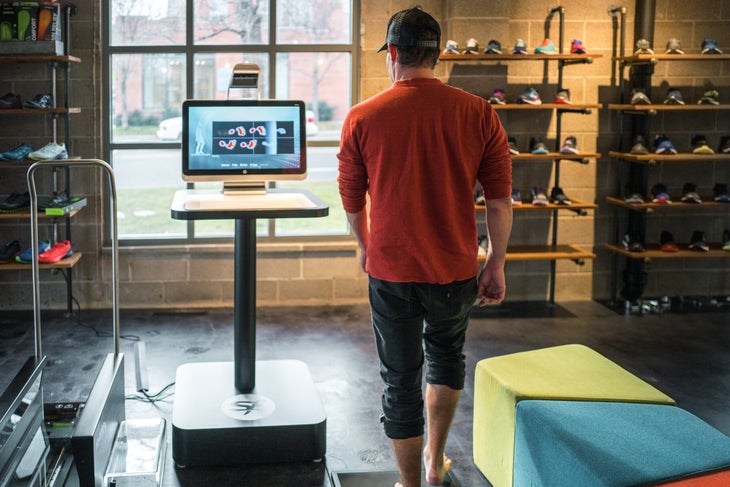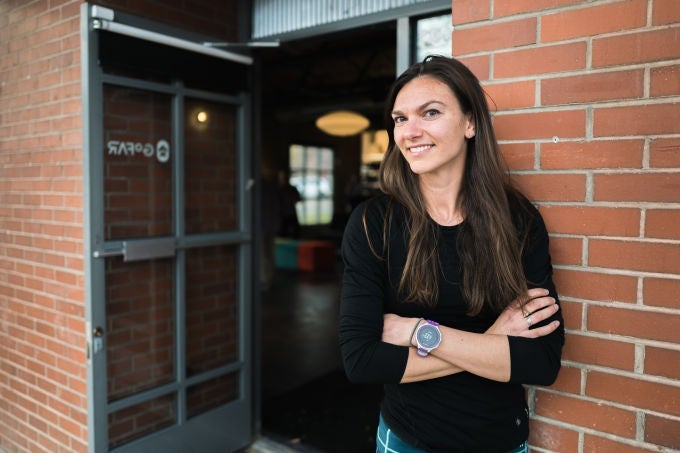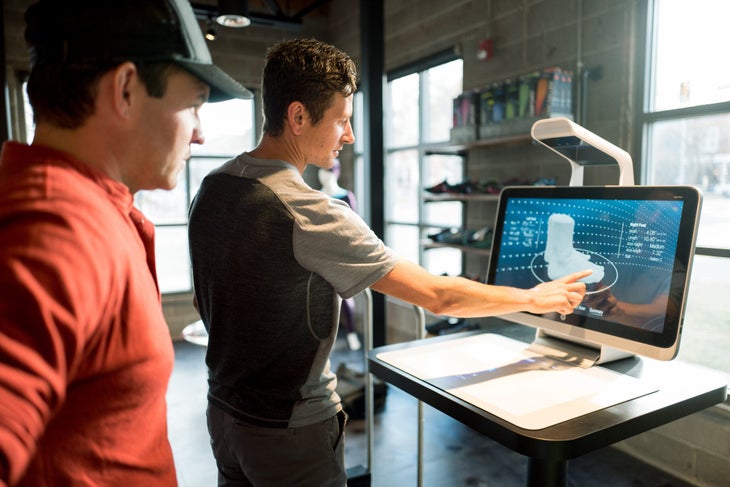The newest store associate at Boulder, Colorado’s Go Far posts up near the wall of shoes on the store’s far end. Her job description at the running and active lifestyle specialty retailer is fairly specific: she’ll measure and analyze your foot, track your stride and gait, and compile your personal biometrics to either order you a custom insole or make a recommendation for the precise shoe and size on the adjacent wall that is best suited for your foot. Essentially, she’s an ace-in-the-hole running shoe fitter, an expert at matching the personal characteristics of your foot, your walking pattern, and needs to the absolute perfect shoes.
The only thing is, she’s not a human. She’s a computer.
Go Far’s techy associate is one of 26 Superfeet FitStations powered by HP implanted in partner running shops across the country. The custom hardware package designed in collaboration with Hewlett Packard includes a medical-grade 3D scanner and a pressure pad, connected to a touch sensitive trackpad and computer screen.
This robot, Superfeet says, represents the next generation of footwear experts.
At Go Far, the system only takes up a little more room than the benches customers would normally sit on to have their foot measured with a Brannock by a flesh-and-blood associate. Instead of that human interaction, customers stand in front of a computer screen, type in their personal information, and follow the on-screen directions (with the help of a human) to place one foot in the scanner, then the other, then walking several times along a rectangular mat.

The Better Brannock
In only seconds, with a detailed 3D rendering of each foot, along with gait and foot pressure data from the mat, users have access to a far more precise analysis of their foot and walking pattern than was ever possible without a physical therapy office.
Currently, the system can use that information to create a custom ME3D Insole—a personalized version of one of Superfeet’s signature off-the-shelf models. Or, users can view a list of the footwear options available at the store they’re in, zeroed into their particular foot shape and other specifications. Clicking on one model of shoe, the system will recommend the optimum size and even show where there might be either rubbing or too much empty space in the less-ideal sizes.

According to Go Far operating manager Kate King, the system is far from completely taking over the shoe-fitting role. A little bit of human help ensures the scan is done correctly. And, she said, the recommendations spit out by the machine are still fairly broad: human employees can narrow it down even more for customers with their personal experience, durability knowledge, reviews, and by knowing the customer’s personal preference. “That’s where we take over and start asking more in-depth questions,” she said.
But King says the FitStation does remove a lot of the subjectivity from determining what a customer needs. More precise data like arch height and length and foot pressure patterns are almost impossible to determine with the naked eye. The computer can better visualize foot pronation and more accurately match that to a shoe. And it can more consistently recommend the right size when fit fluctuates from brand to brand.
And according to Superfeet, this is only the tip of the iceberg. The company contends that a fully-robotic shoe fitter might be closer than you think.
Is Outdoor Retail the Next Casualty of Automation?
A study published last year by the McKinsey Global Institute predicted that by 2030, upwards of 800 million jobs worldwide could be lost to automation, a symptom of rapidly developing artificial intelligence and robotics. The U.S. specifically sees roughly one third of its total workforce at risk, between 39 and 73 million jobs.
Most of the jobs facing takeover fall into physical labor or data processing categories, but Superfeet’s technology could be one of the first signs of automation encroaching on specialty retail, too.
In 2015, The North Face launched an XPS (Expert Personal Shopper), designed to mimic the recommendations of a knowledgeable sales associate. Partnered with IBM’s AI supercomputer Watson, the app allows users to simply type out what they’re looking for—a jacket for rock climbing in Boulder, Colorado, in June, for example. The computer will analyze weather data, the requirements of the activity, and more to produce a collection of options graded from a high to low match, based on warmth, usefulness, insulation type, etc.
“Digital retail continues to transform the way we shop, and embedding cognitive technologies is the next major step in engaging customers,” said Kent Deverell, CEO of Fluid, a design firm that also worked with The North Face and IBM. “By tapping into Watson, XPS aims to provide The North Face shoppers helpful, relevant, and intuitive product recommendations. We believe this kind of engaging, personalized interactive experience will become the norm for online shoppers in years to come.”

In Search of Speed
While XPS was designed to bring brick-and-mortar level employee knowledge to ecommerce, it proved the possibility of automating at least some specialty retail’s most valuable traits in search of the efficiency and speed customers may be trending toward.
According to Rich Hill, president of the outdoor specialty retail community Grassroots Outdoor Alliance, customers at a lot of the specialty retailers currently using FitStations are still looking for a human interaction and the experience that comes from a trained associate. But larger-scale retailers with increased employee turnover and less employee experience might see the most value in automating some of those associate’s jobs and might be the first foothold for this type of automation. “I think the FitStation is probably way better than your average REI employee,” he acknowledged.
But even at Go Far, King thinks automating the shoe-fitting process is a feature some customers might look for. Developing the FitStation’s technology until it can do everything her employees can do would be worthwhile, she said. “For some customers, it’s all about how much we can do, how fast we can do it and despite my thoughts on that, people want convenience and efficiency,” she said. “I personally will always want to interact with a customer but having them be able to come in and do their own scan and maybe it beeps at me when they’re done, that would be an option worth having.”
Pushing the FitStation toward a potentially self-serve product is on Superfeet’s radar, too. Further development of the user experience to make self-scanning easier is on its engineers’ to-do lists, as is improving the footwear recommendations, according to Jim Wnorowski, the product manager for FitStation at Superfeet.
“The feedback we’ve received [from retailers] is to showcase the retailer’s inventory while allowing the salesperson and consumer to filter models based upon a variety of options,” Wnorowski said. “The user experience has the ability to evolve so that we can have an environment than enables any consumer at any retailer to engage with the FitStation platform for their own personalized product development. We want that capability.”
Superfeet’s hope is to leave it up to retailers and their customers to decide what level of automation they prefer. Santa Cruz Running Company has opted to turn off the off-the-shelf recommendations coming from their FitStation. According to owner Tim Schenone, it’s just not necessary. “I feel like I have the best customer service in the country,” he said. “Just scanning the inside of a shoe is not going to get you anywhere near what you need…I do it better.”
Is it Fair?
Grassroots’ Hill sees some inherent flaws in this type of technology, however.
“The biggest value of a specialty retailer is the power of an educated third-party opinion,” he said, noting one of the biggest kinks in automation like Superfeet and The North Face’s: when those opinions come from brands themselves, they’re not as easy for consumers to trust.
“If you picked the ten best pack fitters across the nation and they created a machine to recommend packs, I would believe it. But if that machine comes from Osprey, it’s useless to the consumer,” he said.
Systems like this also have to be able to keep up with a rapidly changing inventory, new products seasonally, and constant updates. According to Hill, by the time systems like the FitStation or XPS add the latest product, it’s already out of date.
Currently, advancements in artificial intelligence, biometrics and data collection, robots and processing power are still a long way from taking over the retail space entirely. Schenone isn’t concerned about the technology taking jobs away from his employees, arguing that the customer service he can provide could never be replicated artificially.
But the one idea everyone agrees on is that technology has a way of advancing uncontrollably. “In a couple years, call me back and I might have a different opinion,” Schenone joked.
King can also see a day when shoe fitting and other retail tasks can be automated to the point where all it takes is a robotic conveyor belt to pull a customer’s choice in footwear from the back shelves and deliver it to the cash register—if a cash register is even necessary. Amazon opened its first retail store in Seattle earlier this year. It uses cameras and sensors, paired with customers’ phones to track and charge them for their purchases. No checkout line, and no cashier.
It’s easy to get lost down the rabbit hole of retail futurism, so to stay in check, Rich Hill likes to remember the boneyard of fixtures and devices (particularly around ski boot fitting—Hill said the only real success has been the trusty Brannock) once hailed as the next big thing that now gather dust in countless retailers’ stockrooms. Could one of gadgets finally break through?
“We have yet to see it. But I think someday, something might stick.”


